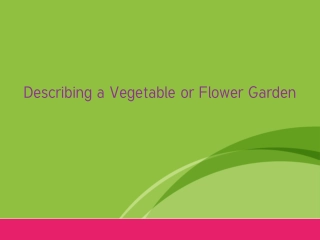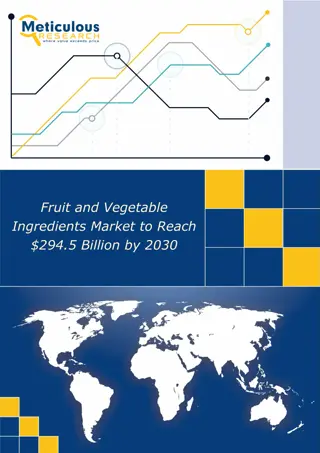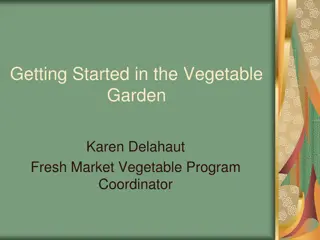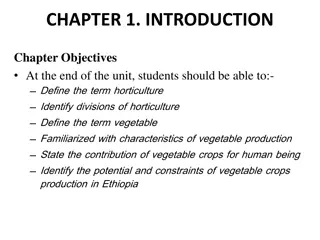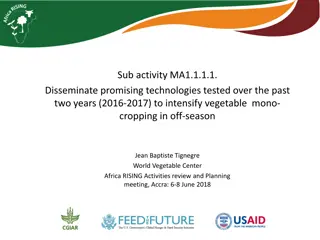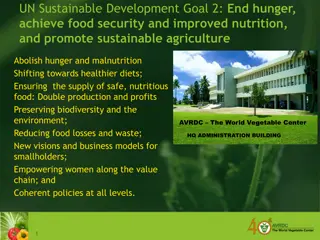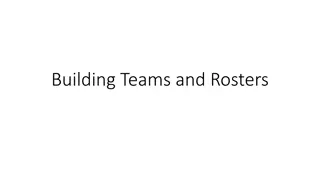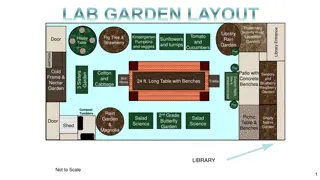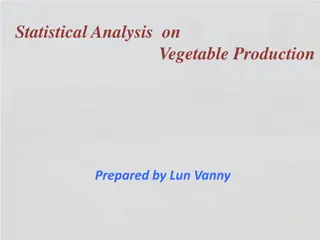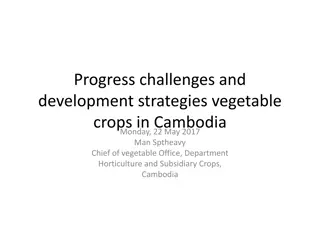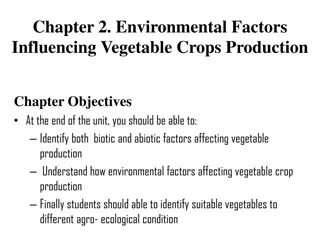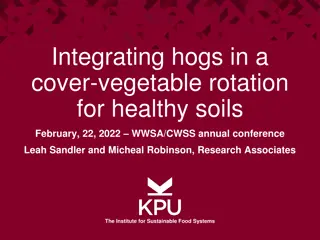Maximizing Your Warm Season Vegetable Garden
Discover practical tips for successful warm season vegetable gardening. From soil temperature management to planting schedules, learn how to optimize your garden for a bountiful harvest. Explore the ideal crops for warm seasons and essential techniques like mulching and row covers to protect your plants from cold snaps.
Download Presentation

Please find below an Image/Link to download the presentation.
The content on the website is provided AS IS for your information and personal use only. It may not be sold, licensed, or shared on other websites without obtaining consent from the author.If you encounter any issues during the download, it is possible that the publisher has removed the file from their server.
You are allowed to download the files provided on this website for personal or commercial use, subject to the condition that they are used lawfully. All files are the property of their respective owners.
The content on the website is provided AS IS for your information and personal use only. It may not be sold, licensed, or shared on other websites without obtaining consent from the author.
E N D
Presentation Transcript
Warm Season Vegetable Gardening Dennis Patton Johnson County K-State Extension Horticulture Agent
Gardening Seasons Warm Cool 80 Cool 70 60 50 40 Mar Apr May Jun Jul Aug Sep Oct Nov Dec
Soil temperatures Cool Season 450 F 2-3"depth Warm Season 550 F late morning Very Warm Season 600 F
Soil Temperatures Measure at least 2 to 4 inches deep Maintain for several days Soil thermometer purchase Kansas Mesonet www.mesonet.k-state.edu 32 degrees at 2 and 4 inch depth
Average Freeze Date A 50-50% Chance of a freeze April 17 50% 60% 70% 80% 90% 95% April 17 April 20 April 23 April 27 May 1 May 7
Cool vs Warm Season Crops Beans Sweet corn Tomatoes Peppers Cucumbers Melons Sweet potatoes Squash and Pumpkins Peas Lettuce Radishes Onions Cabbage Broccoli Potatoes Spinach
Critical soil temperatures Cool season crops - seeds don t germinate, roots don t develop. Plants wait until it warms up. Warm season crops - seeds may rot or roots may not function. Plants may die or not develop.
Know when to plant!
What if it gets COLD? *Must have soil heat to work. Mulching Floating Row Covers 2 to 5 degrees of protection
Tomatoes Transplant mid-May Early planting Must warm the soil Must warm the air
Planting Tomatoes Select short, stocky plants Avoid tall, leggy overgrown plants Don t plant deeper Don t lay on side Slows establishment Plant at normal depth
Pruning Tomatoes Benefits Increase yield Improve air circulation Risk spreading disease Avoid plants when wet Clean tools, hands Tomatoes are typically pruned to the first fruit hand .
Staking, tying, and trellises Utilize vertical space in the garden to maximize productivity. Keep fragile fruit off of the soil Reduced fruit rots Materials Wire mesh Wooden / Metal stakes Poly / Jute string Different systems work in different situations
Tomatoes in Containers Slicing types 5 gallons or larger Cherry types 1 to 2 gallon Compact Vines Size varies Less production
Unconventual Containers Forget them!
Companion Planting Not highly effective Enjoy and have fun
Tomato flowers abort when .. Daytime >95oF Night > 75oF Hot, dry wind Excess nitrogen Fruit set too heavy
Tomato Diseases Septoria Leaf Spot and Early Blight
Foliar Leaf Disease Control Sanitation Air Circulation Proper spacing Staking Fungicide treatments
Blossom End Rot This issue also affects peppers and squash.
Blossom End Rot Deficiency of calcium Under-developed root system Water fluctuations Lush, succulent growth
Disease Resistance Fusarium wilt in tomato. No known control. Persists for 8-12 years. There are 2 strains or races F1 and F2. Need both resistance (A new strain F3 has been discovered in the deep south)
Peppers Less cold tolerant Need warm soils 60 degrees Mesonet.k-state.edu Proper fertilization Regular watering Plant mid-May
Pepper Color Change Start out green Allowed to mature May reduce overall yield
Habanero 100-300,000 Pepper Thermometer Scotch Bonnet 100-250,000 Jamacian Hot 100-200,000 Type and average Scoville units Thai/Tabasco 50-100,000 Cayenne 30-50,000 Hot is produced from an essential oil- capasacin- found in some peppers Serrano 10-25,000 Hot Wax 5-10,000 Jalapeno 2-4,000 Poblano/Ancho 1-1,500 New Mexico/Anaheim 500-1,000 Pepperocini 100-500 Bell 0
Pepper Issues Sunscald Blossom End Rot Anthracnose Bacterial Leaf Spot
Summer squash are used seeds, skin and all. Grow on a compact, bush-type plant
Winter squash grow on a trailing vine. Allow to mature and remove skin and seeds.
Pumpkins are a winter squash, usually round and orange. Usually used for decorative purposes.
Vine Crops Male vs Female flowers Males out number females 3-4 to 1 and come out first.
Squash Issues Squash Bug Squash Vine Borer Mildew
Squash bugs- a gray shield-shaped bug that sucks juices from the plant and releases a toxin that causes wilting and death.
Squash Bug Population Dynamics Overwinter as adults Begin to lay eggs in late May - 1 adult First generation mid June-July 500-600 adults Second generation lay eggs Second generation mid Sept-Oct 62,000 adults
Strategies for Squash Bug Control Reduce overwintering adults (hibernation places) Spray only after the hatch Control in 1st generation Remove vines as soon as fruit are mature Vine removal prevents overwintering and removes hibernation places
Squash Vine Borer Adults emerge early-mid June Lay eggs on base of stems Bore into stems
Squash Vine Borer Control Methods Overwinter in soil pupa stage Sanitation as vines decline Treatments early-June 7 to 10 intervals Spray penetrate canopy
Powdery Mildew Good air circulation Organic option Sulfur Chemical Chlorothalonil Myclobutanil Upper and lower foliage
Extension Master Gardener Gardening Hotline Lawn and Garden Questions! (913) 715-7050 garden.help@jocogov.org Mon - Fri 9 a.m. 4 p.m. 11811 S. Sunset Drive, Suite 1500 Olathe, KS












